#the teacher case study of vanitas
Explore tagged Tumblr posts
Text
These spot the difference games are getting wild.
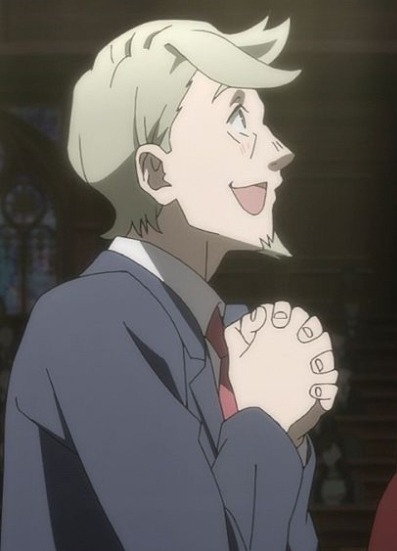
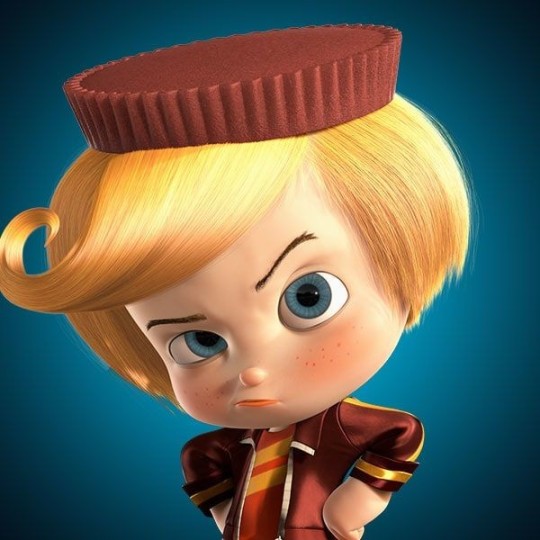
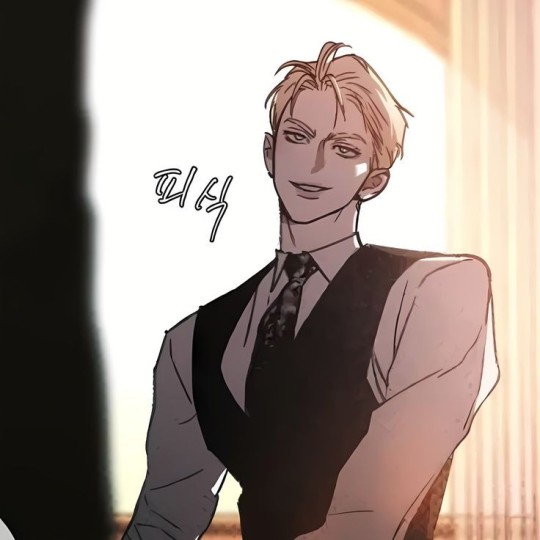
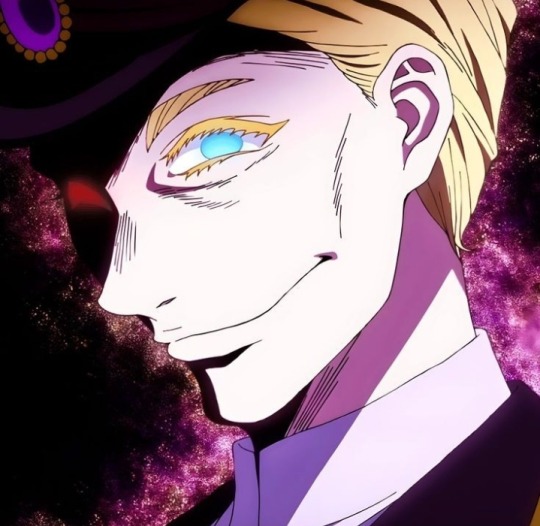
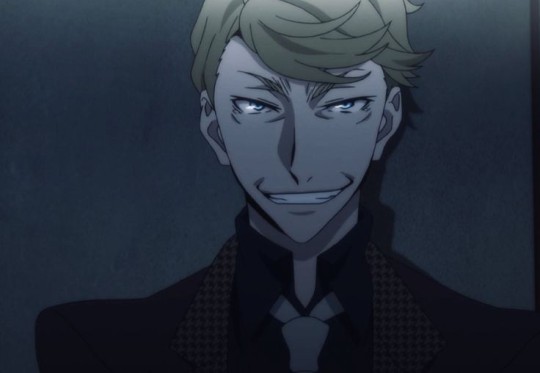
#wreck it ralph rancis#bsd#bsd fitzgerald#f. scott fitzgerald#the guild bsd#bsd francis#case study of vanitas#wreck it ralph#codename anastasia#lookalike#the teacher case study of vanitas#Theyre all blonde with blue eyes#yes fukuchis fanboy is there#fukuchis fanboy
82 notes
·
View notes
Text
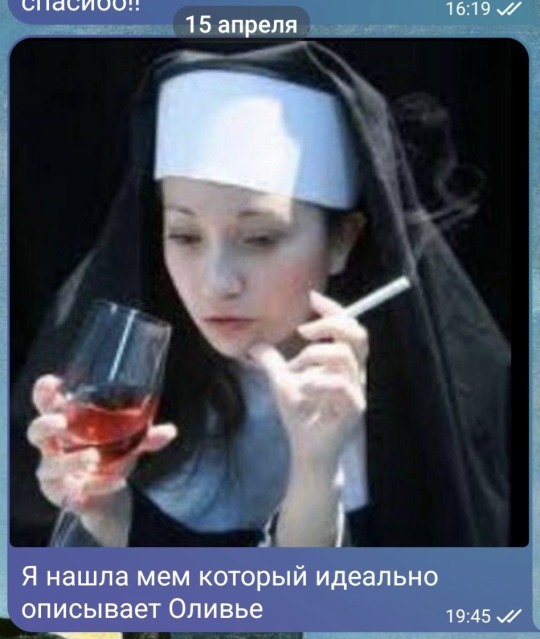
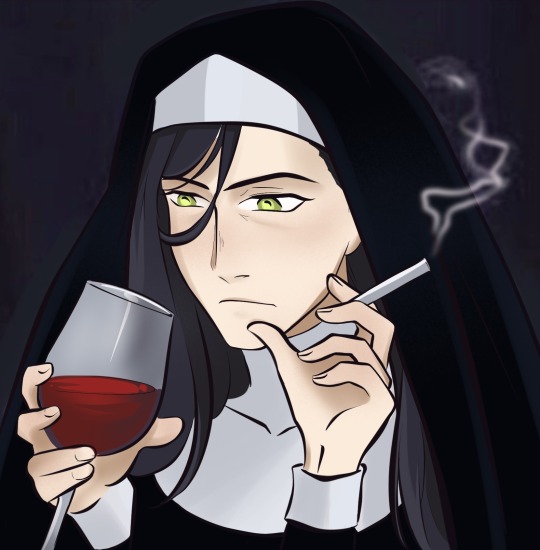
On April 15 I’ve sent my friend this meme as a perfect description of Olivier. Yesterday I found vol 11 omake with Sister Olivier, and then my hand just slipped
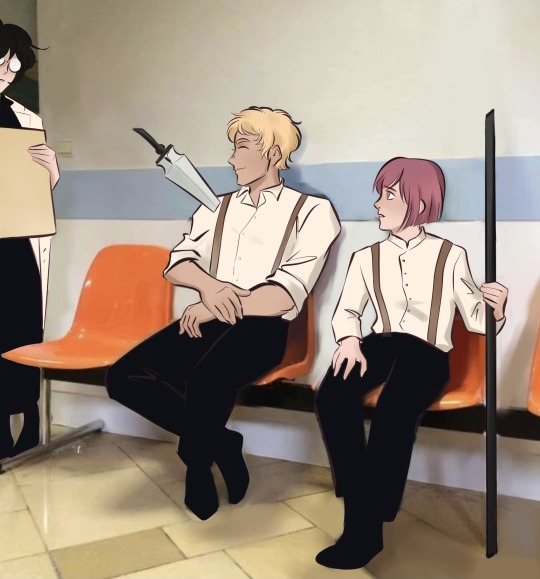

Also now I have some Chasseurs memes (and, apparently, a gift of prophecy) (also the first time I draw Charles is for office meme)
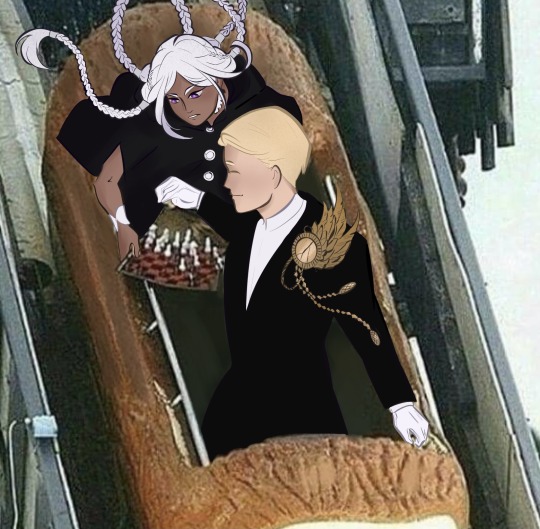
Bonus inspired by second omake: Machina and Teacher being Machina and Teacher
#Vanitas no carte#Vnc#vnc olivier#olivier of obsidian#vnc roland#roland fortis#anc astolfo#astolfo granatum#vnc charles#vnc mira#vnc marquis machina#vnc machina#vnc teacher#comte de saint germain#vnc fanart#the case study of vanitas#memoir of vanitas#mochizuki jun#artists on tumblr#I don’t have serious content today#So have this#lynn lyrae art
476 notes
·
View notes
Text
I've remarked on this blog a few times before that I'm fond of the theory that The Shapeless One is Paracelsus, but I've always hesitated to elaborate, as I felt like there wasn't enough hard evidence that supported this theory being true. However, something recently clicked for me regarding one big parallel between them, and now I can't stop thinking about what that connection would mean for the story thematically.
In mémoire 61, after Machina pushes him to explain what his "plot" is, Teacher declares that he wants to achieve world peace. I've had no idea what to make of this line for a while now, just assuming that we'd need more context to understand what the actual hell he's talking about. But with the Paracelsus comparison, I feel like I'm starting to grasp what's going on there.
[This post needs a VnC-standard warning for mentions of suicide, sexual assault, and child abuse].
There are a few pieces of evidence that support the idea of Teacher being Paracelsus. VnC's Paracelsus is introduced as a great alchemist, just as he was in the real world, and the Count of Saint Germain was an alchemist as well. Nobody knows Teacher's origins, but he's one of the oldest vampires and close with the queen. There's also a little drawing of six-pointed stars that appears behind Paracelsus in the first storybook illustration of him, and those same stars are seen hanging from Teacher's walking stick in the scene where he first meets Noé.


That panel of Teacher and Noé appears at the very end of chapter 6, and the Paracelsus panel appears at the start of chapter 7, meaning these images are quite conspicuously close together.
So what does this mean for Teacher's idea of "world peace"?
In the storybook version of Paracelsus's life, he's described as wanting to alter the world formula not for scientific curiosity, but because he wants to save the world.
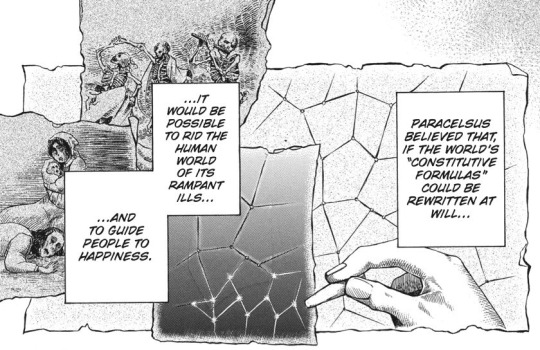
Paracelsus, per the childish version that Teacher presents to Noé, caused the Babel Incident because he was trying to "rid the world of its ills" and "guide people to happiness." The line about the human world's "rampant ills" is read over a drawing of dancing skeletons—a Danse Macabre. This is a Medieval way of drawing the personification of death, usually for the purpose of expressing the way that death comes comes for every person inevitably (the same theme later expressed by Vanitas art).
When Paracelsus speaks of the world's ills, this is the reality he seeks to cure. The world is afflicted with suffering and death, and he wants to rewrite the world's formula so that humanity can live happily without that pain.
A world rewritten to be without suffering—isn't that world peace? "World peace" is often used to evoke an end to armed conflict specifically, rather than suffering at large, but the concepts must overlap if they're pursued seriously. How can world peace last if there are people starving in famines or dying of disease? Suffering breeds violence. And how can someone seeking to alleviate "the world's ills" not want to achieve world peace?
If this is true, if Teacher's hope for "world peace" is him carrying on Paracelsus's legacy (or carrying on his own work, if they're the same man), then what does that mean for Paracelsus's supposed altruistic intentions?
We know little about Paracelsus now, only Teacher's recounting of the Babel Incident by way of a book he's reading to a child, but I think there are two ways to interpret what we do know.
Trying to rid the world of suffering is, on its face, the most noble possible intention. To lead the world to happiness is to attempt to help every other person in the world. And I can think of a lot of ways that Paracelsus's goals make absolute sense to me. If you discover that the fabric of reality can be rewritten, and you know that there are people in the world dying of famines, wouldn't you want to reshape the world so that they no longer have to go hungry?
It's possible, depending on what we find out about him in the future, that Paracelsus really will be a noble figure whose one great sin was hubris, and all he wanted from his research was to help the world in ways that make both moral and logical sense.
However, given some of VnC's other themes, I think there's another lens through which we should consider Paracelsus's actions. We don't know exactly what he was trying to rewrite with that disastrous experiment, but that Danse Macabre does give us one possible clue.
One of the themes that VnC has been slowly developing throughout its run is the idea that, though trying to save a person's life is noble, it is not noble to deny all death as a whole. This is a story about the concept of Vanitas, the idea that death is inevitable and that all else is rendered meaningless in its face. Noé feels like he failed Louis because he was unable to kill him when he asked, and it seems like the manga's being set up to end with Noé killing Vanitas to escape a fate Vanitas considers worse than death. One big part of what makes Mikhail so unsettling is his denial, his laughing about his mother's draining and the fact that he cannot accept the reality Luna has died, and Vanitas is horrified to hear that Misha is planning to resurrect their parent. That same issue goes on to be the one thing that finally drives a wedge between Noé and his teacher, as Noé can apparently forgive the man for purchasing him on the black market and killing Louis, but he's horrified to hear that Teacher told Mikhail that resurrecting Luna was possible.
All of these scenes have other elements to them, other things that drive the characters and inform why these specific ideas of undeath are so deeply horrifying to them, but the buildup of this running theme is an undercurrent through all of it. Vanitas means that someday all people must die, so what does it mean when somebody tries to deny that?
Even further, there's the broader horror of both Noé and Mikhail failing to process the bad things that happen to them. Misha commits blithe horrors in part because he does not understand that his sexual abuse was wrong, so he seems to see no problem with sexually assaulting others now in turn—as he does when he pressures Noé to drink his blood. Noé happily recounts being kidnapped and sold on the black market, remarks on Chloé and Jean-Jacques's goodness minutes after Chloé assaults him in his sleep, and brushes off the incident of Jean-Jacques drugging him to the extent that even Jean-Jacques himself is unnerved by it. All of that is deeply concerning behavior.
Misha is written to be obviously uncanny in his denial, and that uncanniness holds up a mirror to the subtler horror of Noé's own disconnects from reality. The more recent chapters have also begun drawing direct attention to the ways that Noé's denial of the bad in the world becomes problematic. The aforementioned scene of Vani, Dante, and JJ being disturbed by Noé's "it doesn't bother me" line does this, as does the long discussion Noé and Vanitas have about why Noé's ignorance of anti-Dham racism upsets Dante so much.
There is an ongoing tension in VnC between the inherent goodness of peace and life and the horror of what comes when those concepts are taken too far. Noé and Vanitas are this in a nutshell: an endlessly clashing duo made up of a too-extreme pessimist and a too-extreme optimist. The story arcs thus far have taken turns challenging each of their worldviews, slowly pushing Vanitas to open up and let himself hope for peaceful solutions, let himself accept love and emotional closeness, while also slowly pushing Noé to confront the fact that sometimes not everything has a happy-making peaceful solution after all. Sometimes "saving" a child means she has to die, and sometimes an enemy will have an entirely sympathetic reason to hate vampires, but Noé still has to fight them anyway to save the people he wants to save, regardless of whether that enemy is "right" or not.
Noé lives in denial of his own past traumas and his own present-day potential for harm. He denies the potential that "good" people he meets might harm him, and he struggles to accept instances where he has harmed others in turn. Dominique and Vanitas go on for pages after the amusement park about how reckless and overly trusting he can be, and he turns around, unable to cope, when confronted with the truth of what he did to Misha with his claws. However, Noé also has the benefit of his proximity to Vanitas knocking just a bit of sense into him, and it might not be a sure thing that he's going to stay in denial-land forever.
One of VnC's specific points of tension is the question of if/how Noé will grow to accept the hard things that currently bounce off his oblivious denial like water off of a raincoat. The end of mémoire 1, the statement that someday he's going to kill Vanitas, suggests that perhaps he might learn to understand how death, despite its pain, is important in its own right. It suggests that maybe he'll come around to no longer denying death and insisting that salvation is always its avoidance.
However, if he can't quite make that leap, the story provides us with dark mirrors to show us what a monster Noé could become by doubling down on his idealistic, optimistic denial. Misha's current state is Noé to an extreme, an innocent child committing horrors as he utterly fails to process the truth of his own horrific early childhood. Misha's driving motivation is a hatred of pain and suffering, and he's willing to do anything to resurrect the family that saved him from that pain in the past.
Then there's also Lord Ruthven, a man who was once an optimist in Noé's own mold, but has since broken bad in a spectacular way. Noé and Ruthven recite the exact same line about liking both humans and vampires, an obvious parallel, but now Ruthven is working with Naenia. Now he's living in the aftermath of his idealistic peace plan imploding and almost costing him his life. Ruthven despairs the last time he visits Gévaudan, lamenting the wrongness of his naive past hopes for understanding, and now he's working toward some unknown end involving Naenia, Charlatan, and the Queen. Now he's committing horrors of his own, biting at least three people by force, overriding their wills, and associating with the being that steals innocent people's true names.
There's also the question of what the hell Ruthven is doing with the queen. It seems he was somehow involved with Faustina devolving to her current state, and Loki references "smashing up her corpse," so it's possible Naenia's existence may be a sign that Ruthven wants or wanted her dead and/or cursed. However, the shots of him with the Faustina-like body in the tank at the end of mémoire 18 suggest there's a chance that he could instead be involved with some form of resurrection scheme (or a scheme to preserve/save her if she's not yet fully dead).
Ruthven exists in part to demonstrate the ways that an idealist like Noé can go bad, and it's possible that he, like Misha, is attempting some sort of awful resurrection, once again denying the reality of death.
Then, finally, there's one more character with whom Noé has these sorts of obvious parallels. The man who, perhaps, is also meant to represent what Noé could become if the dangerous sides of his optimism aren't reigned in: his teacher.
Noé is fascinated by Vanitas, drawn to him out of care and connection, but also because he wants to observe and understand him to sate his curiosity. In a darker mirror of the same trend, we see Noé's teacher allow Louis, Noé, Domi, and Misha to come to harm at least in part for the simple enjoyment of seeing how they react when placed in dark new situations. Noé and his teacher are also the only crimson vampires we know of who find the Blue Moon beautiful and alluring, rather than a source of fear (assuming that Teacher is a normal crimson vampire).
Noé was raised by this man; his worldview has been shaped by him in countless ways big and small. Noé was already living in cheerful rejection of trauma before The Shapeless One found him, but he could not have remained so radically detached from the painful parts of the world around him if his teacher had not wanted and allowed him to do so. He censored Lord Ruthven out of Noé's education, and he apparently did the same with anything that discussed (or expressed) severe bigotry toward Dhampirs. How else did Teacher shape him, and to what goal?
We know that the Shapeless One taught Noé how to fight. Given that "world peace" line, I wonder if perhaps he may also have taught him his morals on wanting to avoid conflict.
Teacher is a contradiction. He talks about "world peace," but he blithely leads Louis to his doom and supposedly doesn't hesitate to half-kill anyone who calls him by the wrong name. Marquis Machina calls him an incomprehensible natural disaster for this reason. Yet, despite all his rampant cruelty, I'm beginning to think that he might be just as much of a dangerous optimist as his student.
Teacher is defined by the fact that, in every scene, he always seems to look like he's having fun. There's hardly been a single panel where he's not drawn smiling. Sometimes that fun is vicious, a cruel smile made as a threat to Vanitas when he fails to address him by his name, but just as often, his aura seems horrifically innocent. He's just a man with a sweet smile and rather dull eyes having a very good time with life.
In the past I've largely looked at this smile as an extension of Teacher's sadism. He toys with Louis and Noé for the fun of it, and I took his smile as an expression of his cruel enjoyment of the pain he creates in his wake. However, now that we've seen him interact with Machina, now that we've observed him speaking casually with a peer for an extended period, there seems to be a disturbingly sincere quality to him as well.

Based on how he's portrayed in mémoire 61, when Teacher says he does everything he does for the sake of "world peace," I honestly think I believe him. I don't believe that he's not a villain—I can't guarantee that his vision of "world peace" would even align with a normal person's definition of "peace" or "happiness," but I believe that he's speaking some version of honestly here.
There's an honest to goodness optimism in that ever-present smile. There's a hope and a genuine quality to what he announces to Machina, in contrast to his smiles of sweetly cruel schadenfreude.
So perhaps, if all that is true, if Teacher is another dark mirror to Noé and he really does want to bring about world peace, then the point of him is that "world peace" has the potential to be a horror. What is the pursuit of world peace if not the ultimate pipe dream of every idealist in the mold of Noé and Ruthven? And what is VnC if not a long catalog of the horrors that idealists can bring about if they aren't careful?
And that, finally, brings me back to Paracelsus and the Danse Macabre.
Depending on what Paracelsus wanted to achieve through his experiments, it's possible he may have been yet another character trying to escape the harsh reality of death. The line about the world's "rampant ills" is placed over the Danse Macabre, after all—a symbol of death's universal inevitability. Is that the painful ill that Paracelsus wanted to address by rewriting the world formula? Inescapable death itself?
If so, Paracelsus becomes the ultimate embodiment of what happens when one denies death's certainty and the necessity of that certainty. He's the ultimate denial of "Vanitas" and what it represents on a scale far larger than Noé, Misha, or even Ruthven could grasp. And the manga casts his failed experiment as a Tower of Babel, throwing the world into chaos and causing countless deaths in his failure's wake.
Meanwhile, Teacher seems to have some ideas about how to cheat death in the present day, as he's promised Misha that there's a way to bring "The Vampire of the Blue Moon" back to life. This could be a lie, of course, or he could be planning to bring back "the vampire of the blue moon" in a way that does not actually bring back Luna as an individual. However, even trying to bring back the Blue Moon in some other way, perhaps through the human Vanitas, still represents him trying to restore something he found beautiful that was lost because of death. It still ties him thematically to the perversion of death as an ending, the same as Mikhail and Ruthven.
So far every character we've seen that wants to undo death is cast as an antagonist. Ruthven, Mikhail, and The Shapeless One are all united by a cruelty and a perverseness in various forms, and their goal is part of this. Death is a tragedy, but although trying to save the lives of people who want to live is noble, attempting to undo or eternally escape death is a far worse horror.
If Teacher is Paracelsus, or if they're closely connected in some other way, then that serves to further this point and show how the horror of escaping death extends to Paracelsus as it does the others. Teacher is strange and cruel. Paracelsus might be a nobly hubristic historical fool in a storybook, but if these two characters are connected, that instantly reveals the unsettling truth of how wrong Paracelsus's potential attempt to thwart death would have been. Nothing Teacher is working for can be wholly good.
And, just as Noé and Misha's denial is both present and harmful beyond the most severe subject of death, even if Paracelsus wasn't trying to craft a world without death by altering the world formula, we know he was trying to create a world without suffering. Again, this is a noble goal in theory, but so long as death remains, some suffering will remain as well. Crafting a world without pain and suffering can also go much too far, can slip into denial and cruelty. Mikhail's whole motivation as an antagonist is his search for a life without pain, and look where that's led him.
A rejection of all suffering can be an extremely dangerous thing, whether it's running from one's own mental pain or wanting to rewrite the world to negate all suffering as a whole. This dream will never not be a detachment from reality.
The Case Study of Vanitas is a series that seems to be searching for a balance of optimism and pessimism, a way to approach the harsh realities of life that lies between the toxic extremes embodied by Vanitas and Noé. To lapse too far into hopeless pessimism creates a Vanitas, a Chloé, an Astolfo. It creates people who are suicidal, genocidal, or both, and dangerous to themselves and others for it. However, to go through life in a state of eternal joy without processing one's pain, or to attempt to create a world wholly free of suffering—that is just as dangerous and foolish. What are Noé, Misha, and Ruthven if not dangers to themselves and others? What is Teacher if not the most dangerous man in this manga?
Noé and Misha are unsettling because they smile through the bad things that happen to them and act as though they aren't bad. They each have some exceptions to this rule—Louis's death for Noé and the pain suffered at the hands of Moreau for Misha—but they still come across as at times disconnected from the reality of pain.
Yet, neither of them is as disconnected from the reality of pain as a man that can behead the grandson he raised with a smile on his face. Noé as a child sees the fun in being kidnapped and put up for auction. Teacher, if his smile is to be believed, sees the fun in every single thing we've seen him do, and that's what's so unsettling about him. He genuinely seems to be having a good time, including and especially when he's blithely committing horrors for the fun of it.
Noé and Misha's strange behavior stems from trauma, and we don't know that's the case for Teacher. Perhaps not, as he seems much colder and crueler in his tendencies than either of them. But either way, the happy sincerity displayed by both of them is echoed in the face of the Count of Saint Germain as he tells Machina that he's searching for world peace. That is the face of someone idealistic, someone who believes he's working toward a real goal that both justifies and delights him.
Teacher wants world peace, and his warped nature means that we have no real idea what "world peace" means to him. Is a world at peace a world where he still gets to violently beat people who get his name wrong? A world where he still gets to have fun observing the free will and choices of the traumatized children he raises? Maybe he once believed in a world that was truly without suffering, and his overly-long life and mad optimism have eroded his tether to reality, turning him into the awful person we see now. Maybe the catastrophe of the Babel incident broke him and turned him from a hubristic idealist to warped echo of his former self. Maybe he somehow thinks all the suffering he causes is justified if it's in pursuit of his noble end goal. Maybe his version of "world peace" is a world where all people can live free from the fear of death, and the smaller pains caused along the way are irrelevant in the face of that impossible dream.
Or maybe he's just a cruel hypocrite.
In the end, we still know too little about both Paracelsus and Teacher to make any grand proclamations about the truth of their characters. However, I can't unsee this connection between them now that I've seen it. Teacher is one of Noé's dark mirrors, a character that represents the horrors possible when one goes too far down his current emotional path. Noé is optimistic to a fault, convincing himself to see only the best in many truly awful scenarios, and Teacher is the man with an eternal smile printed on his face. Noé loves and wants to save Vanitas, and Teacher speaks of the Blue Moon's ultimate beauty and says he has a way to bring them back to life now that they're dead. Noé is the eternal savior, always desperate to prevent people from dying, and Teacher claims that everything he does is done in the name of achieving world peace.
Similarly, Paracelsus is defined by throwing the world into chaos and horror due to his over-optimism. He tried to go too far, tried to rid humanity of its countless ills and create his own form of world peace, perhaps even tried to rewrite the reality of death. Did he hate pain and cold like Misha? Did he want to stop unjust wars like Ruthven? Did he want to become a savior in the image of Noah?
If Teacher's goal of "world peace" is to be believed, then whether or not Teacher and Paracelsus are actually the same person, they represent the same thematic extreme. Death is inevitable, says the concept of Vanitas. It's inevitable and Noé must learn to accept that fact before he does something awful in the name of pain and death's prevention. Teacher and Paracelsus have both done something(s) awful in the name of pain and death's prevention. Teacher and Paracelsus have followed Noé's path of optimism to such an extent that they, in one way or another, both claim(ed) to want to save the world, and this requires a mad extreme of Noé-like cognitive dissonance and hubris.
Paracelsus pursued some goal, some way of granting humanity happiness that was supposedly noble but still murky in its specifics, and he warped the fabric of reality and caused the countless disasters of the Babel Incident in the process. And that's assuming the storybook is true, and Babel really was accidental on his part. Meanwhile Teacher has warped the seemingly noble dream of world peace into something that he can claim is served by the way he's tormented Louis, Misha, and Noé. There's a chance that both men tried or are trying to undo the reality of death. They're bound by the same underlying current of scientific curiosity intermingled with their dreams of world peace.
Noé is not an alchemist, and he's not particularly skilled at rewriting the world formula. He's unlikely to have any chance to rewrite the fabric of reality itself for the better. He's unlikely to have any chance to achieve "world peace" by any definition.
Noé is, however, a dangerous optimist who has not yet learned that death is unavoidable. He hasn't yet learned that death can be preferred to its alternatives. And he was raised by a man who seems like he has not learned or does not care that disrupting Death in the grand sense will inevitably lead to horror. Or perhaps a man who enjoys horrors and wants to toy with absolute death as a part of that. And all this in a world warped and defined by the folly of a man who may also not have understood the horror of evading death.
So Teacher might be Paracelsus. I think this connection between them only strengthens the odds of that theory being true. But even if he isn't, they represent a similar thing for Noé and for the manga's themes at large. You cannot rid the world of the Danse Macabre, and attempting to end that dance will only bring greater ills and greater pain than death on its own could ever hope to bring.
A strange and dangerous man proclaiming with an honest smile that he wants to bring about world peace does not make him any less strange or dangerous. Depending on his definition of world peace and his idea of death's place in it, that idealistic goal may actually make him far more dangerous than if he were nothing more than a simple sadist.
#I've talked at length about some of these ideas in other posts before#but putting this together felt like finally being able to marry a few different major themes I've written about#that have stayed largely disparate up to this point#also huge shoutout to the several other theorists I've seen point out the thing with teacher and paracelsus and the stars#that's such a cool detail#ANYWAY this is more of a reach than what I'd usually stake a whole meta essay on. but I feel like my thematic foundations are sound#vnc#vanitas no carte#the case study of vanitas#teacher#vnc teacher#the shapeless one#comte de saint germain#vnc paracelsus#teacher my beloathed#noé archiviste#theory#english major hours#vnc spoilers
78 notes
·
View notes
Text
If I had a nickel for each time a female mangaka put in their shonen series a mysterious, eccentric being based on the Count of St. Germain I would have two nickels.
Which isn’t a lot but it’s weird it happened twice right?


#anime#manga#the case study of vanitas#les memoires de vanitas#count of st. germain#teacher vnc#the millennium earl#the Earl#dgm#vnc#d gray man#jun mochizuki#hoshino katsura
73 notes
·
View notes
Text
I’m too drained to give this parallel the careful thought it deserves…but child!Dante, nibbling away at bonbons to stave off hunger while he waits for a mother who will never return.
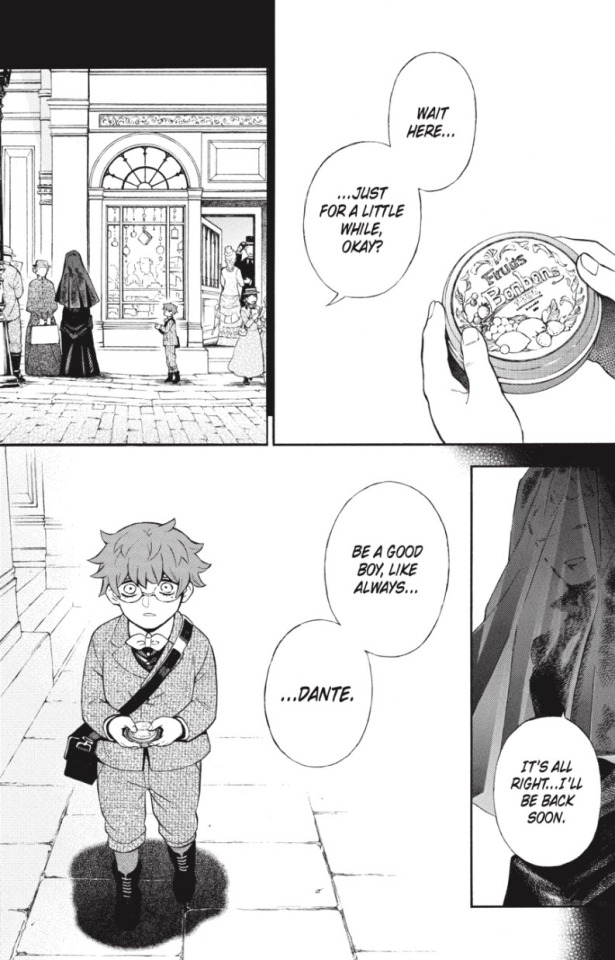
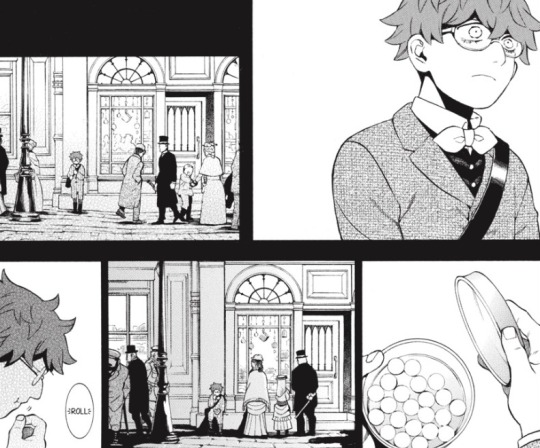

Dhampir kids eking out a living outside the cloak of Marquis Machina’s patronage by selling a drug named ‘miel’ that bears a striking resemblance to bonbons…
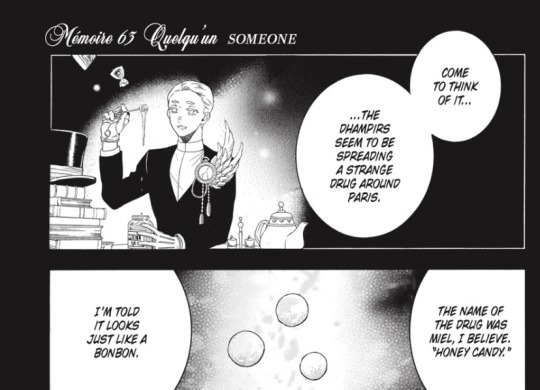

Mochijun’s too purposeful of a writer for that to be mere coincidence.
#vnc spoilers#vnc 63#vnc 61#vnc#vanitas no carte#the case study of vanitas#dante#johann#marquis machina#francis varney#lady archiviste#teacher#the shapeless one#comte de saint germain#gano
69 notes
·
View notes
Text


Sensei
#vampire#comte de saint germain#vnc teacher#vnc sensei#inktober 2024#inktober#the case study of vanitas#vanitas no carte#vnc#vnc fanart#traditional drawing
28 notes
·
View notes
Text

[based on a scene from the fic "à chacun son goût" by almost_home] as you can see i'm very normal about it!!!
#comtemisha#the teacher#mikhail#vnc#vanitas no carte#les memoires de vanitas#the case study of vanitas#art tag
23 notes
·
View notes
Text
Vanitas no carte theory
It's probably been pointed out before, and I haven't read the manga yet but...


Is Noé's teacher his cat also?
I mean, think about it. Aside from the obvious similarities in their eyes, this guy has been referred to as the Shapeless one, it could mean that he can switch bodies, shapes, if you will.
#noé teacher#murr vnc#noé archiviste#noés cat#the shapeless one#the case study of vanitas#vanitas no carte#vnc noé#vnc vanitas#vnc#les memoires de vanitas#anime theory#im an idiot
29 notes
·
View notes
Text


So...
I'm re-reading Pandora Hearts, and this panel of Levi is another point toward the similarities between him and the Shapeless One.
Noé...I'm so worried for you...
#levi baskerville#the shapeless one#the teacher#comte de saint germain#vanitas no carte#vnc#the case study of vanitas#pandora hearts
28 notes
·
View notes
Text
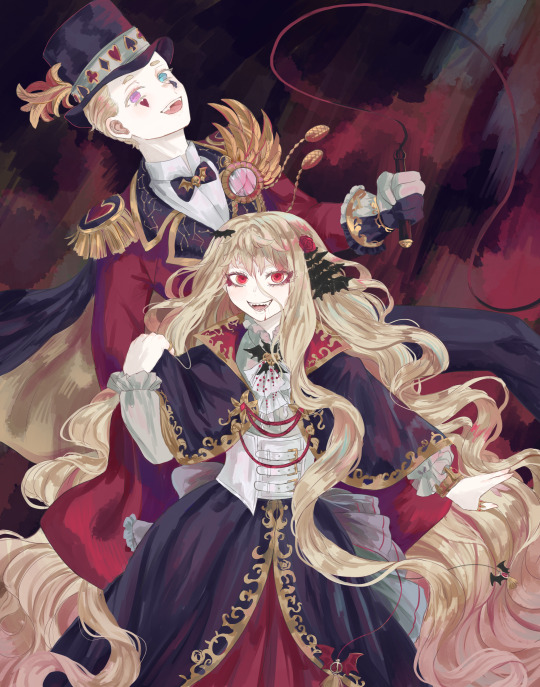
dracula faustina & lion tamer germain 🎃
#my art#vnc#vanitas no carte#the case study of vanitas#queen faustina#comte de saint germain#teacher#faustina#naenia
132 notes
·
View notes
Text
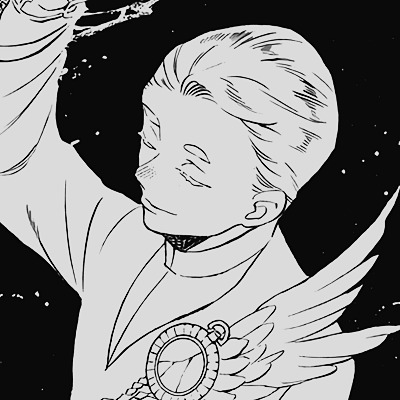





116 notes
·
View notes
Text
i had a very important realization while i was out walking today. out of the main four vnc characters, noé is the one we know the least about. he fits into a category of what i would call the glass protagonist–a guy who basically exists only to narrate the story, joining the ranks of those like nick carraway and richard papen, except he's just like way more mysterious.
see, part of what makes a narrator like nick work narratively is that we know just enough about him to 1) understand his perspective on the events of the story and 2) know what his role in the story is. nick is able to give his insider/outsider view of gatsby because he is neither part of the buchanans' world nor part of gatsby's, and his role in the story is to serve as a kind of mediator between the two of them. he's daisy's cousin in long island, but he's also a working man in city, etc, etc.
the funky thing about noé is we just...don't know anything about him. we're told a couple of things about his childhood; that he was adopted by an old couple in the human world, that they died and he was somehow on sale in altus, and that the comte took him in. but really, the time before and after louis's death is uncannily empty for the guy who we're following through this world. yes, of course it's fair to say that we know the most important things about noé, but we honestly know way more of vanitas's childhood than his, and that's a big part of the central mystery of the story.
(there's an element to this, of course, that comes from both of the examples i gave before, the great gatsby and the secret history, being novels. as readers, we get an extra level of introspection from nick and richard that is very difficult to translate directly into manga as a medium. however, i would argue that it's not impossible, and all that being said it does sometimes feel intentional on mochijun's part just how little of noé's background she's shown us.)
both nick and richard narrate their respective stories onto the reader from their position as outsiders, which we know is noé's role in vnc from the get-go. i mean, he says this explicitly in chapter one: "this is the tale of how i met vanitas, and how we walked together, of all we gained and lost, and of how, at the end of that journey, i would kill him with my own two hands". he's the narrator and this is his story, just like nick and richard, right?
but while nick and richard are the narrators, and give us, the readers, an excuse to look into their worlds, they are not exactly essential players on the board. both the great gatsby and the secret history give the impression that, without their narrators, they would have continued nearly exactly as written; the characters were doomed to fail long before the story began, and the intervention of some white guy isn't enough to either stop that. and yes, vanitas is doomed as well, but we are introduced to his death as an event that is intrinsically tied to noé himself.
"with my own two hands", noé says. he is not only an actor in the saga leading up to vanitas's demise, he is a starring player in it. (and yes, we ofc later learn that vanitas is going to die with or without noé's intervention but i think it's important to understand that this is our introduction to noé, vanitas, and the story itself) in this way, noé differentiates himself from his glass counterparts, in that he inserts himself irrevocably into the plot. he is both a character in the story and an observer, a chess piece and the one playing the game. this is why the gaps in his backstory feel so jarring, at least to me, because we are not meant to view him as solely a window into the world of vnc, but as a character all on his own.
anyways, all that being said, i'm hoping with the introduction of lady archiviste we're finally going to learn more about noé and his time with the comte, just because it's like a HUGE gap in the story.
#i think it goes without saying that domi's line about noé being a hermit for the past several years really stuck with me bc like. what.#she just dropped that line and then it was never mentioned again#noé also says in chapter one that he was sent to paris by his “former teacher”#like what does that mean. has he just not seen the comte in several years? has he been living somewhere else? what happened between them?#sometimes i think that maybe noé himself doesn't remember everything but ig we'll see#noé archiviste#vanitas#vnc#vanitas no carte#the case study of vanitas#the great gatsby#nick carraway#the secret history#richard papen#sorry if this got a little rambly by the end ahhhh
104 notes
·
View notes
Text
VnC timeline
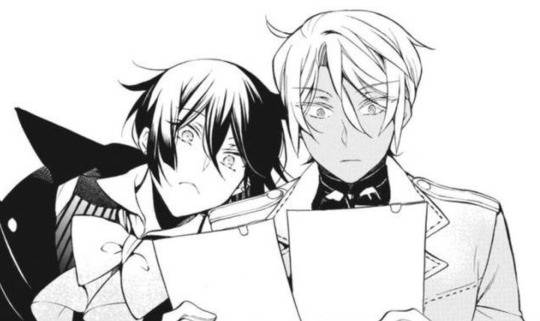
I’m mostly an artist in this fandom, but sometimes inspiration strikes and leads me in completely weird directions, such as… figuring out dates of every event in VnC!
With the invaluable help of @retracexcviii, who has created timelines for VnC events before (thank you forever and ever💜) and helped me to avoid some really silly mistakes, I’ve done… this monstrosity of a text, which includes every important canon event I could think of.
— All events are distributed by centuries, starting with XVI and finishing with XIX, and after listing all the events of each century I will put screens of the same texts with correlating manga pages. Additionally, there are numbers of chapters for most of the events.
— Some dates are marked with ~, which means that this date could fluctuate a bit (could be a bit earlier or later).
— Events that I couldn’t put anywhere specifically are in “UNKNOWN MOMENT” category. I still tried to differentiate them between centuries.
Alright, here we go!
XVI CENTURY
1493-1500 — creation of an engraving; plague, cataclysms, Paracelsius is looking for a way to save humanity.
(7)
~ 1500 — Babel. The awakening of Faustina, who is considered to be the first vampire.
(19)
1500-1550 — the awakening of Teacher and Machina as vampires. Machina might be younger than Teacher. Creation (awakening?) of Luna? The awakening of Teacher and the creation of Luna — probably around the same time?
(19)
~ 1550-1560 — Chloe is born. She becomes a vampire at the age of 4.
(31)
Between 1550-1600 — Ruthven becomes a vampire. He is currently more that 200 years old, and it’s unknown whether he was born as a vampire or awaken or even when exactly his life began. But looks like an adult in 1650, so he was most likely alive in 1600. He is also younger than Chloe: when she calls him a “child”, he doesn’t correct her.
(31)
Presumable order of awakening of the oldest vampires:
Faustina —> Teacher —> Machina —> Chloe —> Ruthven.
When exactly was Luna born? Does Kresnik exist in this century?
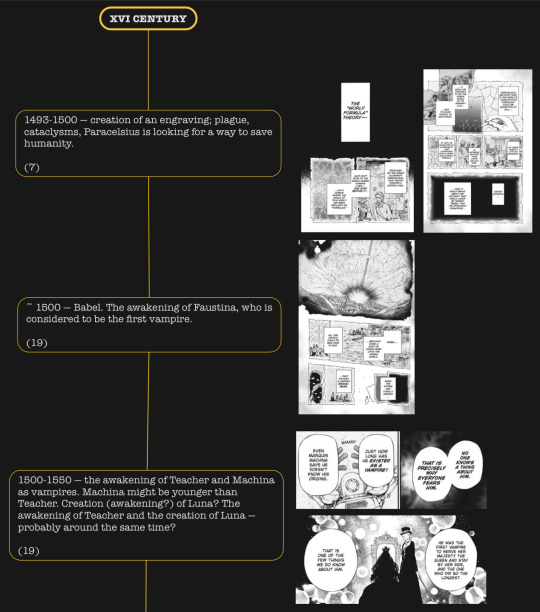
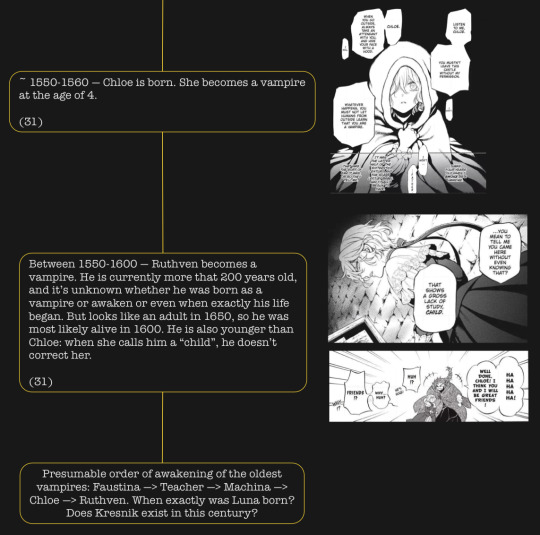
XVII CENTURY
~ 1650 — the war between humans and vampires. Chloe meets Ruthven.
(31)
~ 1665-1669 — Jeanne awakens in a flask in front of an unknown person. She leaves the flask. Later, she is adopted by Eric and Louise, Ruthven's students.
(39)
~ 1669 — Chloe meets Jeanne. Ruthven tries to establish peace between humans and vampires.
(31, 32)
~ 1672 — (3 years after Chloe and Jeanne met, 30 years before the end of the war) Ruthven loses his students, his eye is injured; Jeanne becomes the Bourreau of the Senate; Chloe meets Machina; Machina tells about the fate of Ruthven and Jeanne. Almost immediately, Naenia appears for the first time (indicating that Faustina is already a cursebearer); Ruthven visits Chloe for the last time, they part as enemies. If Naenia exists, does Charlatan exist as well?
(32, 33)
UNKNOWN MOMENT BEFORE 1672 — Faustina becomes a cursebearer.
(33)
UNKNOWN MOMENT BEFORE 1672 — Luna creates the Books of Vanitas, which are considered to be the reason for the appearance of the Malnomen. Could the books be created to cure the cursebearers in the first place? Most likely, this happened early in the timeline, since there is a whole folklore about it. Even earlier, someone gave Luna the name " Vanitas", which is also reflected in the title of the books.
(48, 49)
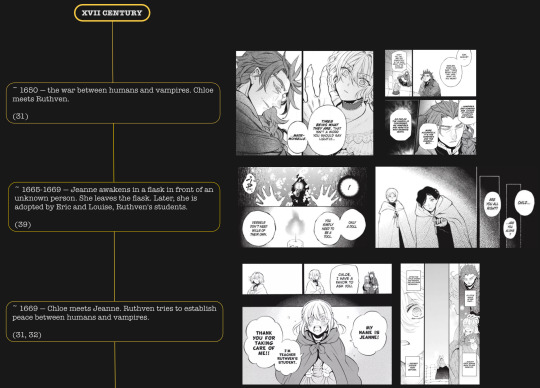
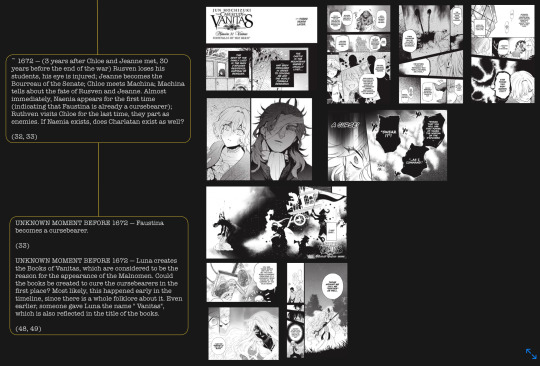
XVIII CENTURY
Before 1702 — Ruthven joins the Oriflamme family, becomes one of the Queen's advisors and a senator. The Queen is still alive, but she is also active as Naenia. Luna sees Jeanne in battle.
(33)
1702 — the end of the war. According to the pact, vampires move to Altus and sell Astermite to humans in exchange for other goods.
(33, 59)
1764 — Chloe spends more than 50 years alone. Death of village girl Jeanne, who speculated to be killed by a Beast, but was a victim of radical anti-vampire group. On the same day, she is visited by Naenia and then meets Jean-Jacques. The Beast conspiracy continues.
(36, 33)
1767 — Chloe witnesses one of the murders and reveals her vampiric powers when she defends herself. After that, the general belief is that Chloe is the master of the mysterious nonexistent Beast and both are the culprits. Her human family is killed. A few days later the Chasseurs (Vampire eradication fraction?) and Ruthven come to Gévaudan. Jean-Jacques becomes a Cursebearer to protect Chloe. Jeanne, now the Hellfire Witch, finds Chloe. Chloe tries to jump off a cliff, but Naenia comes to her again. Chloe also becomes the Cursebearer. Jeanne kills other hunters, but Ruthven saves her, makes her give him an oath (she tries to resist) and puts her in deep sleep. The Beast stops attacks. Conspiracy between Ruthven and the Chasseurs presumably continues.
(35, 36, 37, 43, 39)
UNKNOWN MOMENT BETWEEN 1672-1702 — Luna witnesses Jeanne in a fight with vampires. Later, after 1767, Luna also knew about Jeanne’s sleep.
(4)
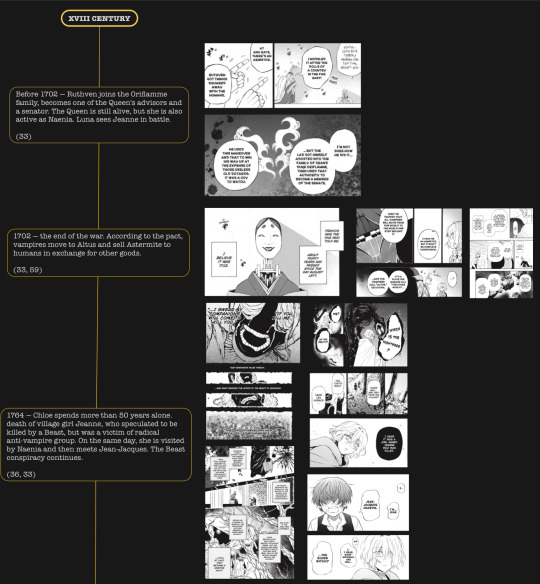
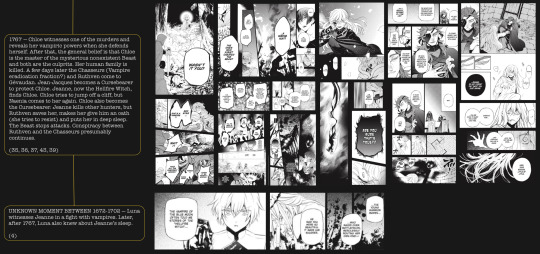
XIX CENTURY
1861 — Olivier is born.
1862 — Roland is born.
1868 — Dominique and Louis are born. Teacher takes Louis.
(46)
1869 — Noé is born.
1870 — Vanitas is born; Dante is born.
1873 — Astolfo is born.
~ 1875 — Olivier meets Roland.
(58)
~ 1874-1875 — an elderly couple finds Noé. They live together for some time.
(9)
~ 1876 — Mikhail is born. Luca is probably born around the same time or a bit later.
~ 1876-1877 — Noé is kidnapped and ends up in a black market, gets an eye injury and is bought by Teacher. Noé meets Domi and Louis (their proportions are quite similar to Astolfo in his childhood flashbacks, where he is presumed to be around 8 years old, but Noé looks younger, so here I’m assuming Noé and the twins could be 6-7 or 7-8 years old). // Probably around the same time, Dante is abandoned by unknown woman. He meets Johann and Riche. Absence of his glasses and bandages indicate that there could be at least a few weeks or months between the two events.
(9, 61, 62)
~ before 1881 — Vanitas is orphaned and placed under the care of the Church as a potential future Chasseur, but is kidnapped by Moreau for secret experiments.
(49)
1881 — sketch of the Tower of the Sun by Amédée Sébillot, electrical engineer. He worked with engineer Jules Bourdais on this project, but in fact the tower was unrealizable. If the monument designed by Sébillot was real, it would have collapsed under its own weight.
Before or early 1881 — Roland and Olivier move to Paris. Roland is injured, but it’s unknown how it happened. Olivier’s hairstyle may indicate that it happened earlier than the time when Roland almost died.
(46.5)
~ 1881 — Roland (vice-captain) is injured while defending Olivier. Olivier was injured too. // Misha (who looks about 5 years old??) meets Roland, but later ends up in Moreau's laboratory, where Vanitas is already located.
(47)
~ 1881-1882 — Astolfo secretly meets a vampire. When Astolfo befriends Olivier, he tells him about this secret. The death of the Granatum family. Astolfo meets Carl, Roland (his injuries, which were still visible when he met Misha, have already healed) and other Paladins. Olivier definitely had a title of Obsidian by the time of Granatums’ murder, so some time passes between the day Astolfo met a vampire and the day of Granatums’ murder.
(48, 58)
~ 1882-1883 1881-1882* — Louis dies. Domi learns the truth about her and Louis being twins. // Luna saves Misha and Vanitas when they destroy Moreau's lab*. Moreau joins the Charlatan. Misha agrees to be bitten by Luna. Later, Luna loses their true name; Misha loses their arm; Luna dies by Vanitas’s hands. Vanitas and Misha inherit the Books, but are separated, and Teacher takes Misha.
*@torterrachampion mentioned in reblog that Noé is officially 12 years old when Louis’s died ang provided an image from a booklet for the Blu-ray of the anime. I completely missed that fact, so thank you for bringing it up! I’ve decided to change the time range for this event to 1881-1882 for better accuracy.
*It is likely that Noé witnessed Louis’s death around the same time Vanitas and Misha were saved by Luna; bonus card features Noé in the same outfit as on the day of Louis’s death together with Vanitas dressed in his lab clothes. 1881 or 1882 is a possible year for Louis’s death and salvation of Vanitas and Misha. In this scenario Luna dies later than Louis.
(9, 46, 51, * bonus card)
1887 — possible start of construction of the Tower of the Sun (in reality, the construction of the Eiffel Tower started on 28 January 1887).
~ 1887-1888 — Astolfo and Roland have a conflict.
(59)
UNKNOWN MOMENT (after 1702?) BEFORE 1888 — Veronica and Loki, along with Machina, become Beastias, and Antoine enters the Senate. How old are Veronica, Antione and Loki?
UNKNOWN MOMENT (not earlier than 12 years?*) BEFORE 1888 — “death” of Faustina at the hands of her Beasts and Rusven. Luka replaces her on the throne, but the Senate controls him. Strangely, he isn’t even officially presented yet. It’s unknown how old he was when he assumed his current position, but it’s unlikely that the Senate and Beastias would “kill” the Queen without choosing a suitable successor first.
*Alternatively, it could happen earlier, if Loki, Luca’s older brother, was supposed to inherit the throne prior to becoming a cursebearer as well, but was replaced with Luca. But this is a pure speculation.
(38, 13)
UNKNOWN MOMENT BEFORE 1874 — Archivists disappear. It’s unknown whether there are any living Archivists other than Machina and Noé in the present. It’s also unknown why Noe thinks about blood when he thinks about his clan.
(57)
UNKNOWN MOMENT BETWEEN 1871-1888 — Vanitas meets Teacher, or Saint—Germain, who at that time had a different appearance. Were Luna alive at that moment?
(55)
UNKNOWN MOMENT BEFORE 1888 — Machina becomes patron of the dhampires and creates her network of information brokers.
(62)
~ 1888 (before current events) — Astolfo and Roland become Paladins. // 6 month before — Teacher goes somewhere. // 1 month before — Jeanne awakens from her sleep.
(13, 4)
1888 — Teacher asks Noé to witness the story of the Book of Vanitas via correspondence. Current events begin.
(1, 52)
Possible future event — The Exposition Universelle of 1889, which was held in Paris, 5 May to 31 October. The Tower of Sun (instead of Eiffel Tower in VnC universe) was created for this fair. However, at least some of the buildings were ruined.
(44, 20.5, 46, 55)
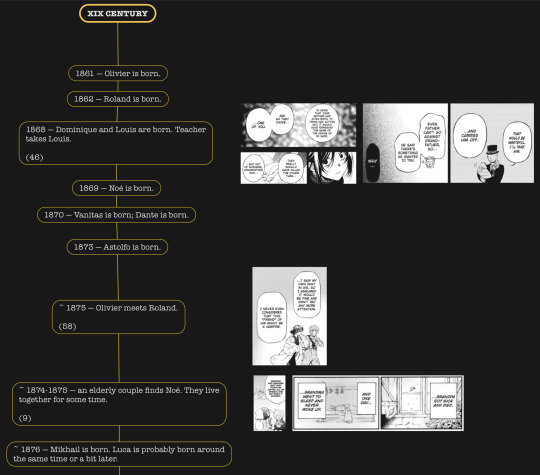
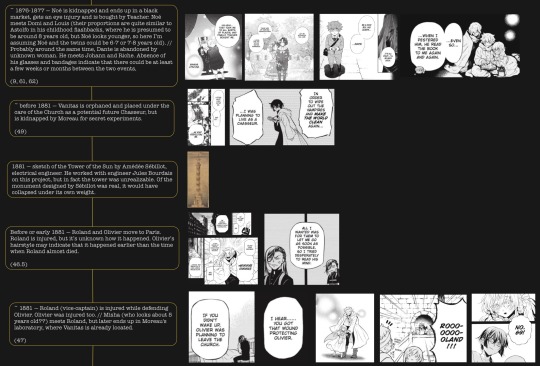
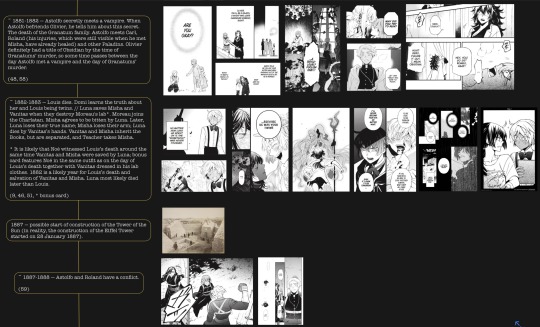
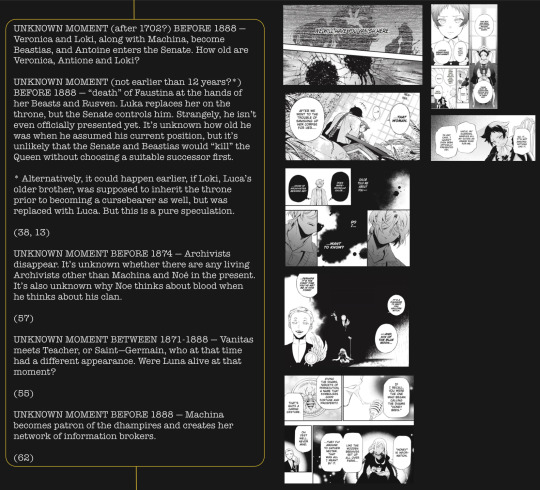
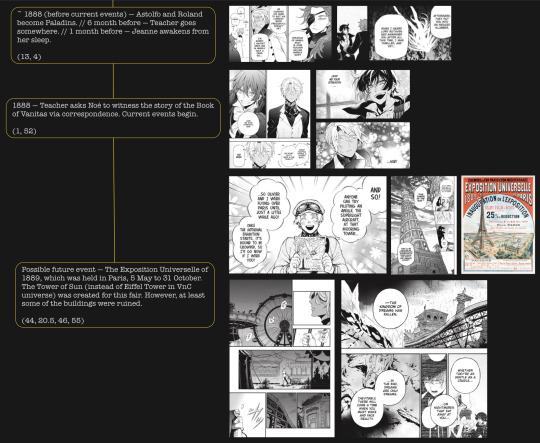
That’s it for now! I think I will update this post in future when we have enough new information to define unclear dates and add new details and whatnot~
#vanitas no carte#the case study of vanitas#memoir of vanitas#vanitas no shuki#vnc meta#vnc theorie#mochizuki jun#mochijunverse#vanitas no carte meta#vanitas no carte timeline#vnc timeline#not official#vnc spoilers#vnc#vnc noe#vnc vanitas#vnc dominique#vnc jeanne#vnc teacher#vnc ruthven#vnc chloe#vnc naenia#vnc chasseurs#vnc louis#vnc beastias#vnc luna#idk if I should use name tags here honestly but this is related to them?? whatever let it be
320 notes
·
View notes
Text
It's been said before, but I do really love how VnC seems to have taken it upon itself to spend time on every one of the classic themes associated with vampire literature.
Vampirism as a disease? Vampirism as seduction and/or sexual assault? Vampirism as an excuse for othering and xenophobia? Fear of the corruption of natural death? It's all there. VnC vampires aren't traditional vampires in any part of their actual lore, but god, Mochijun knows what she's doing on a thematic level.
#the corruption of death thing hasn't been as big a theme quite yet. but it's lurking around the edges#particularly with Misha's desire to resurrect luna and the way that concept is portrayed#and I suspect that idea is going to connect back to teacher's own fixation on luna and/or whatever's going on with the queen as well#and there's the fact that vani's going to die at the end. and that that's preferable to whatever the Mark will turn him into#god I love this series#vnc#vanitas no carte#the case study of vanitas#english major hours
280 notes
·
View notes
Text
That little Gojo Deku hybrid is a conniving one isn’t he
#ooh that guy used so much power he pulled a kung fu panda three#hes a creepy one#Dominique popping off with her sword was SO hype#it was so cool#i knew something was up about his teacher#i couldn’t get a good read on him#i knew he was shifty but i didn’t know he was evil#his reveal was so shocking it kicked on the true crime inverted filter#oh hes not dead gojodeku is back#I wasn Noe to kill me#bro thats a whole marriage proposal#just kiss or something#poor Michael does NOT want a Vanoe wedding#he started crying tears of anguish#his face was CREEPY#so much happened#vanitas#noe archiviste#dominique de sade#jeanne the hellfire witch#i got his name wrong#its Mikhail#the case study of vanitas#vanitas no carte#vnc
7 notes
·
View notes
Text
So here’s some stuff we need to sit on. Firstly, Lady Archiviste is likely Teacher’s former pupil. I’m assuming it was during the time Faustina was alive and Teacher was her right hand man. Could explain that look she gave Noé as in “oh…my replacement.”
Now, how many people know? Because this is a big deal and I don’t think someone like Ruthven knows. Does Antoine know? Veronica? If she knows, that’s also pretty wild bc Lady might’ve told her. Speaking of which, I am so curious about their relationship. Are they in kahoots? Is this just a fling, friends with benefits? Are they fucking dating? I wanna know how genuine their relationship is. Bc if Veronica is lowkey in love with her that’s major given her character. Idk maybe it’ll make her open her heart a little.
#anime#manga#the case study of vanitas#vanitas no carte#jun mochizuki#vnc chapter 62#les memoires de vanitas#vnc manga#tumblr#vnc#manga spoilers#veronica de sade#lady archiviste#teacher vnc#senate
25 notes
·
View notes